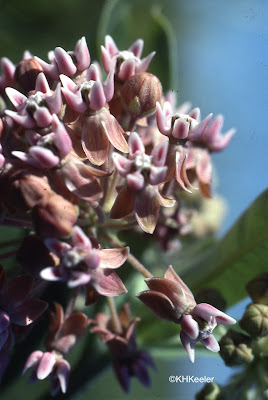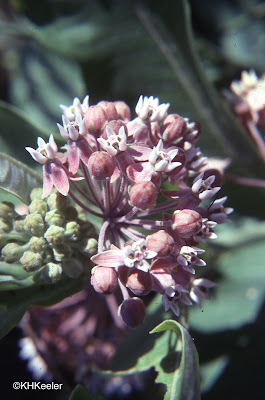 |
| common milkweed, Asclepias syriaca |
 |
| wild milkweeds in Colorado, showy milkweed |
However, not everyone should just write away for free seeds and toss them into their yard. My concerns are from the point of view of growing well-adapted native plants. If the plant dies, you've wasted your time and energy and any monarch caterpillars relying on it die too. Conversely, introducing troublesome new weeds would be an undesirable outcome of this campaign. Plant the right milkweed for your area.
North America is a big place and no milkweed is native across the entire continent. Thus, the right milkweed--native, adapted to local conditions--varies across the continent.
Choosing the right milkweed is more difficult in some places than in others. The most famous monarch butterflies, those from the eastern United States, overwinter in the mountains of Mexico and come north in the spring, first to breed in Texas and a month or so later, monarchs that hatched in Texas fly into the central midwest to breed themselves. For all those areas, the common milkweed, Asclepias syriaca, is native, fast growing, hardy, and the preferred food of monarch butterfly caterpillars. Planting the common milkweed from central Texas to the Canadian border and east to the Atlantic will hugely improve conditions for monarch butterflies.
 |
| common milkweed, Asclepias syriaca |
Colorado is between the two regions and rarely mentioned in monarch butterfly/milkweed discussions.
The central U.S. gets drier and drier going west to the base of the Rocky Mountains. The common milkweed drops out in eastern Kansas and the native roadside milkweed of Colorado is the showy milkweed, Asclepias speciosa. Historically, monarch butterflies generally stayed on the eastern side of the Great Plains, where common milkweed grows. Monarch butterfly populations may have dropped in Colorado and Wyoming, but they were never considered important parts of the North American monarch butterfly populations, but rather a place that monarchs migrated through or wandered into accidentally.
 |
| showy milkweed, Asclepias speciosa |
 |
| showy milkweed, Asclepias speciosa |
The showy milkweed is the native, hardy milkweed that people on the Front Range see growing on roadsides. It needs less water than the common milkweed so is a better choice for Colorado's low rainfall. (Common milkweed, if grown here, should be treated like Kentucky bluegrass and given supplemental water). As you can see from my pictures, showy milkweed looks a lot like the common milkweed.
Both common milkweed and showy milkweed will spread from rhizomes (belowground stems) forming clumps from a single plant and often coming up some distance away. Gardeners need to be prepared to cut back unwanted stems.
Also native to Colorado, and being given away as free seeds by Minnesota's Save Our Monarchs (link), is Asclepias incarnata, the swamp milkweed. This is a handsome plant with reddish pink flowers. However, as its name indicates, it is a plant that requires a lot of water. It will not do well in dry Colorado gardens. The Flora of Colorado says it is found "along ditches and streams, in marshes and in other wet areas of the plains and foothills." (Ackerfield 2015 p. 93). For gardens that run down into wetlands or with a swampy component, this is terrifically beautiful plant and a fine monarch butterfly host.
 |
| swamp milkweed, Asclepias incarnata |
Another very attractive prairie milkweed loved by monarchs, butterfly milkweed (also known as butterfly weed and pleurisy root, Asclepias tuberosa), is native here on "sandy, gravelly or calcareous (chalk, limestone) soils in open woodlands or pinyon-juniper communities, 5000-7000 ft." (Ackerman, p. 94). That makes it sound abundant but it is not common. In western Colorado it is found "near springs" (Weber and Wittmann, 2012 p. 59). Butterfly milkweed is also found across most of eastern North America, areas all generally moister than the plains of Colorado. The University of Missouri describes it as drought-tolerant, but eastern Colorado's normal is St. Louis's drought. In a watered garden or with some shade it should survive, and, in the right spot, thrive.
 |
| butterfly milkweed, Asclepias tuberosa Kansas prairie |
 |
| butterfly milkweed, Asclepias tuberosa eastern Nebraska |
The discussion above focuses on the Front Range of Colorado and applies to the plains of eastern Colorado. In the Rocky Mountains and for areas of the Western Slope, the milkweed to plant is still showy milkweed (see Xerces Society on the Great Basin) though butterfly milkweed is a lovely choice if you have wetlands or have water to spare. Note that western Colorado is the far eastern edge of the range of the western monarch butterflies.
One might think since Colorado is not on the mainline of monarchs that it is irrelevant for Coloradans to grow milkweeds. I'd take a different approach. What if we make this a welcoming place for monarch butterflies? We live in an era of change. Scientists in the Arctic or working on mountain tops are recording the arrival and survival of animals that could not previously live in that area. Animals (and plants, but they're slower) move as conditions change. If monarch butterflies encounter a rich supply of milkweeds, they are likely to leave eggs. If those eggs survive, we can gradually develop breeding populations of monarch butterflies for whom the Colorado is home, aiding nationwide efforts by helping expand monarch breeding grounds.
Comments and corrections welcome.
 |
| monarch butterfly seen in Maryland, Sept. 2015 |
References
Ackerfield, J. 2015. Flora of Colorado. Botanical Research Institute of Texas, Fort Worth, TX.
Finley, B. 2014. Rescue strategy hatching for dwindling monarch butterflies. The Denver Post Dec. 27, 2014 link
Monarch Watch link
SaveOurMonarchs.org is giving away swamp milkweed seeds link Their pollinator seed mix will get you started gardening for pollinators, but it is made of plants that are native in many places, not local to any particular area. Choosing local natives works better for any particular spot, but gardener has to learn what those are.
Taylor, O. R. (Chip). Monarch butterfly conservation: the challenges ahead. Aug. 2013.YouTube Video https://www.youtube.com/watch?v=fh42KGh-TkE
Weber, W.A. and R. C. Wittmann. 2012. Colorado Flora, Western Slope. 4th edition. University of Colorado Press, Boulder.
Xerces Society (Invertebrate conservation) link
Kathy Keeler
More at awanderingbotanist.com
Join me on Facebook: https://www.facebook.com/AWanderingBotanist
Great Article with a beautiful vision...having just relocated from New Jersey to Denver and a lover of the Monarch Butterfly ...one of my many questions is "will I see the Monarch Butterfly?" I continue to run a program back East for urban youth and one of my favorite projects is Teaching with Monarchs - Journey and Transformation though a wonderful organization Monarch Teachers Network.
ReplyDeleteMonarch butterflies come through Colorado. I remember seeing one last year. Four days ago I saw a monarch flying through my backyard. That's the only one I've seen this year--but if you aren't outside you won't see them and I haven't been able to spend many hours in the garden recently--so I was (and am) delighted.
ReplyDeleteWhen is the best time to plant seeds? Which would you choose for the Black Forest or Monument area? The hatch or migration of Painted Ladies that happened last week was absolutely delightful! I'd love to see more butterflies in our area!
ReplyDeleteSherri, you can Winter Sow seeds right now, if you didn't put some out in the Fall.
DeleteEasiest is to put seeds in in the fall but some seeds will die over the winter. Planting in the spring is usually more successful but read and follow all the instructions http://www.monarchwatch.org/milkweed/prop.htm In particular, give them a cold treatment--so think about them in February and start the process then.
ReplyDeleteLoveland Colorado. We are moist stratifying three pods of seeds from a single milkweed we found on our property last summer. Will be seedbed raised from mid-March until after last frost. We going to establish a raised bed of milkweed, but I suspect it will be a waste of time and land. We have never seen a Monarch in the five years we've lived here. Where might I get a Monarch egg case(?) to put into this dedicated milkweed bed to maybe get a local population started?
ReplyDeleteWhat a wonderful project! Monarch Watch, Monarch Butterfly Garden and ButterflyBushes.com all have various stages of monarch (eggs, caterpillars, chrysalis) available. And lots of information from them online about raising monarchs but I'd recommend explaining your project to them before buying to make success more likely. Good luck!
ReplyDeleteWe just moved to Delta a few weeks ago. Showy Milkweed is all around the irrigation ditches that border our property. I discovered a big stand of it at a place where Sandhill Cranes migrate through each spring. Lo and behold I spotted a Monarch on it two days ago. I participate in iNaturalist.org and documented it on a project there Milkweed Watch. Many other insects were taking advantage of the milkweed as well. Enjoyed finding your article today.
ReplyDeleteWe have a "Monarch Pass" on Hwy 50 east of Gunnison for a reason.
ReplyDeleteThanks. I never made the connection.
DeleteI have close relatives who live just a few miles from Monarch Pass, and they say there is nary a Monarch or Viceroy anywhere within 50 miles of the Leadville/Monarch area. My relative says the pass was changed from Garfield to Monarch because the locals consider that pass to be the king of passes in that part of the state. It's a tourist thing and a community pride thing. Butterflies have ZERO connection to the name.
ReplyDeleteI live in Loveland. I have not seen ANY Monarch here for the past 10 years. I contacted one of the Monarch preservation organizations about getting some larvae for the milkweed I have in my yard, and was told I was wasting my time because "Colorado will never be relevant to Monarch restoration".
Glenn
DeleteThanks. Since eastern and western monarch populations both end at the base of the Rocky Mountains, going over a pass seemed unlikely--but is a lovely image.
In 2017 there were monarchs in the painted lady mass migration: I saw them at Devil's Backbone feeding on the rabbitbrush flowers. I wasn't around much in 2018.
I live just north of Boulder, CO, and have showy milkweed on my property. I have seen monarch caterpillars on milkweeds by my gate two of the past 5 years. I now have a 200 square foot patch of showy milkweed in my field, and have already seen a couple of monarchs this summer. Maybe CO isn't hugely significant, but I was pleased to see these butterflies clearly reproducing at my place.
ReplyDeleteWonderful!
DeleteI planted showy milkweed in colorado springs widefield security and last year found a beautiful monarch Caterpillar on it....then became a butterfly male
ReplyDeleteVery cool. We are raising monarchs in Colorado!
DeleteI live in Centennial (near 1-25 and C470). Showy Milkweed started growing in our yard a few years ago, and have a pretty nice patch now. We try to grow a hummingbird, bee and butterfly friendly garden and this year we had two sightings of monarchs a few weeks apart. First we've seen moving here in 2002. I'm thinking of seeding in other varieties into my garden (swamp, antelope, common and butterfly weed). Any thoughts?
ReplyDeleteButterfly weed and swamp milkweed are the other two species recommended in Colorado. Swamp milkweed needs a lot of moisture. Antelope and butterfly will do better in dry soils. The only one of your list I'd argue against is common milkweed: its range is the East, ending in eastern Kansas. It is aggressive, so we're likely to see it escaping in Colorado. Showy milkweed grows in the same kinds of places but is native from the Front Range west.
DeleteThanks, I appreciate the advice, especially about potential invasive species.
DeleteThis comment has been removed by the author.
ReplyDelete